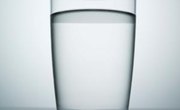
Freeboard is a design characteristic of a vessel. For small boats, it is the minimum distance from the top edge of the side of the boat, or gunwale, down to the waterline. The weight of the loaded boat equals the weight of the volume of water it displaces. The boat's weight affects the freeboard because the heavier it is, the lower the boat sits in the water. The displacement or weight of the vessel and its physical dimensions determine the theoretical freeboard of the boat.
Items you will need
Tape measure
Pencil and paper
Calculator
Find the length of the boat from the boat's specifications or measure the length at the expected waterline.
Find or measure the height of its side or gunwale from the keel. This is the minimum vertical distance from the bottom of the hull to the top of the side.
Find the boat's beam or measure its maximum width.
Calculate the effective area of the hull by multiplying the length at the waterline by the beam and a factor of 0.6. This factor corrects for the shape of the hull in boats without flat bottoms, as most of them are.
Find or estimate the weight of the boat and add it to that of the passengers and contents. This is the displacement of the vessel.
Divide the displacement by the density of water, which is approximately 62 pounds per cubic foot. This is the volume of the water displaced by the submerged boat.
Divide the displaced volume by the cross-sectional area of the submerged part of the boat calculated above. The result is the submerged depth of the boat.
Subtract the submerged depth from the gunwale height. The result is the freeboard.
EXAMPLE:
A boat with a V-shaped hull is 12 feet long with a width of 36 inches, or three feet. The boat weighs 100 pounds and, with two passengers and gear, its displacement is 500 pounds. The shortest vertical distance from the keel to the top of the gunwale is 15 inches.
The effective area of the hull is 12 feet * 3 feet * 0.6, or 21.6 square feet.
The 500-pound displacement divided by the water density of 62 pounds per cubic feet is about 8.1 cubic feet of water.
Dividing the 8.1 cubic feet by the boat's area of 21.6 square feet yields 0.375 feet, or 4.5 inches of water. Subtracting 4.5 from the 15-inch height of the gunwale produces a freeboard of 10.5 inches.
Tips
- If the boat has a relatively flat bottom and the hull shape is simple enough to approximate with a small number of polygons, calculate the boat hull's area directly without using the 0.6 factor. In this case, measure the hull width at several points and approximate its shape with composite figures. Calculate the overall area as the sum of the areas of the individual polygons. This will usually be a rectangle for the aft part of the boat and a triangle or rhombus for the bow.
References
Tips
- If the boat has a relatively flat bottom and the hull shape is simple enough to approximate with a small number of polygons, calculate the boat hull's area directly without using the 0.6 factor. In this case, measure the hull width at several points and approximate its shape with composite figures. Calculate the overall area as the sum of the areas of the individual polygons. This will usually be a rectangle for the aft part of the boat and a triangle or rhombus for the bow.
Writer Bio
Don Patton began writing after retiring from an engineering career in 2006. He holds a Bachelor of Science in electrical engineering from the University of California at Berkeley and continued with graduate study in software engineering.



